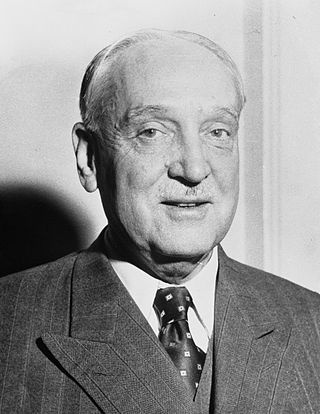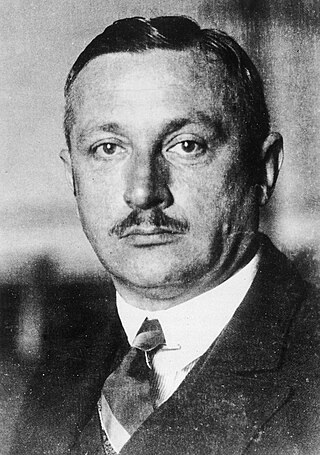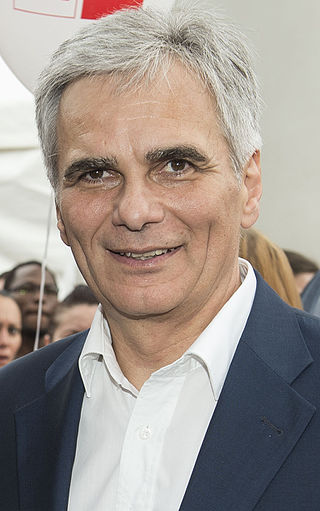
Politics in Austria reflects the dynamics of competition among multiple political parties, which led to the formation of a Conservative-Green coalition government for the first time in January 2020, following the snap elections of 29 September 2019, and the election of a former Green Party leader to the presidency in 2016.

The Austrian People's Party is a Christian-democratic and liberal-conservative political party in Austria.

Karl Renner was an Austrian politician and jurist of the Social Democratic Workers' Party of Austria. He is often referred to as the "Father of the Republics" because he led the first government of the Republic of German-Austria and the First Austrian Republic in 1919 and 1920, and was once again decisive in establishing the present Second Republic after the fall of Nazi Germany in 1945, becoming its first President after World War II.

Julius Raab was a conservative Austrian politician who served as Federal Chancellor of Austria from 1953 to 1961. Raab steered Allied-occupied Austria to independence, when he negotiated and signed the Austrian State Treaty in 1955. In internal politics Raab stood for a pragmatic "social partnership" and the "Grand coalition" of Austrian Conservatives and Social Democrats.

The president of Austria is the head of state of the Republic of Austria.

The Communist Party of Austria is a communist party in Austria. Established in 1918 as the Communist Party of German-Austria (KPDÖ), it is one of the world's oldest communist parties. The KPÖ was banned between 1933 and 1945 under both the Austrofascist regime and the Nazi German administration of Austria after the 1938 Anschluss.

Leopold Figl was an Austrian politician of the Austrian People's Party and the first Federal Chancellor after World War II. He was also the youngest Federal Chancellor of Austria after the war before Sebastian Kurz.

Adolf Schärf was an Austrian politician of the Socialist Party of Austria (SPÖ). He served as Vice-Chancellor from 1945 to 1957 and as President of Austria from 1957 until his death.
The Christian Social Party was a major conservative political party in the Cisleithanian crown lands of Austria-Hungary and under the First Austrian Republic, from 1891 to 1934. The party was affiliated with Austrian nationalism that sought to keep Catholic Austria out of the State of Germany founded in 1871, which it viewed as Protestant and Prussian-dominated; it identified Austrians on the basis of their predominantly Catholic religious identity as opposed to the predominantly Protestant religious identity of the Prussians.

Parliamentary elections were held in Austria on 10 May 1959. Although the Socialist Party (SPÖ) received the most votes, the Austrian People's Party won one more seat than the SPÖ. The Communist Party of Austria lost its remaining three seats and has not returned to the National Council since. Voter turnout was 94%. The grand coalition that had governed the country since 1945 remained in office, with People's Party leader Julius Raab as chancellor and Socialist leader Bruno Pittermann as vice-chancellor.

Parliamentary elections were held in Austria on 22 February 1953. They were the elections in which the Socialist Party received the most votes since 1920. However, the Austrian People's Party won the most seats. The grand coalition between the two parties was continued with Julius Raab replacing Leopold Figl as Chancellor of Austria, who had had to resign after facing criticism from his own party, and Adolf Schärf of the Socialist Party remaining Vice Chancellor.

Parliamentary elections were held in Austria on 9 October 1949. About 500,000 registered Nazis, who were not allowed to vote in 1945, regained their voting rights. A newly created party, the Electoral Party of Independents (WdU) specifically targeted this group of voters and immediately won a large share of votes. The Austrian People's Party remained strongest party, although losing their absolute majority of seats. Leopold Figl stayed as Chancellor, leading a coalition with the Socialist Party of Austria as junior partner.

Rudolf Ramek was an Austrian Christian Social politician, who served as Chancellor of Austria from 1924 to 1926.

The Government of Austria is the executive cabinet of the Republic of Austria. It consists of the chancellor, who is the head of government, the vice chancellor and the ministers.

Austria was occupied by the Allies and declared independent from Nazi Germany on 27 April 1945, as a result of the Vienna offensive. The occupation ended when the Austrian State Treaty came into force on 27 July 1955.

Werner Faymann is an Austrian former politician who was Chancellor of Austria and chairman of the Social Democratic Party of Austria (SPÖ) from 2008 to 2016. On 9 May 2016, he resigned from both positions amid widening criticism within his party.

The Federal Chancellery of Austria is the ministry led by the chancellor of Austria. Since the establishment of the First Austrian Republic in 1918, the Chancellery building has served as the venue for the sessions of the Austrian cabinet. It is located on the Ballhausplatz in the centre of Vienna, vis-à-vis the Hofburg Imperial Palace. Like Downing Street, Quai d'Orsay or – formerly – Wilhelmstrasse, the address has become a synecdoche for governmental power.

The Social Democratic Party of Austria is a social democratic political party in Austria. Founded in 1889 as the Social Democratic Workers' Party of Austria and later known as the Socialist Party of Austria from 1945 until 1991, the party is the oldest extant political party in Austria. Along with the Austrian People's Party (ÖVP), it is one of the country's two traditional major parties. It is positioned on the centre-left on the political spectrum.
Since its foundation in 1889, the Social Democratic Party has often been one of the main political forces in Austria. At the start of the First World War it was the strongest party in parliament, and on the ending of that war in 1918 the party leader Karl Renner became chancellor of the First Republic. The party lost power in 1920, but retained a strong base of support in the capital Vienna. A period of rising political violence culminated in the banning of the Social Democratic Party under the Austrofascist dictatorship (1934–38).























